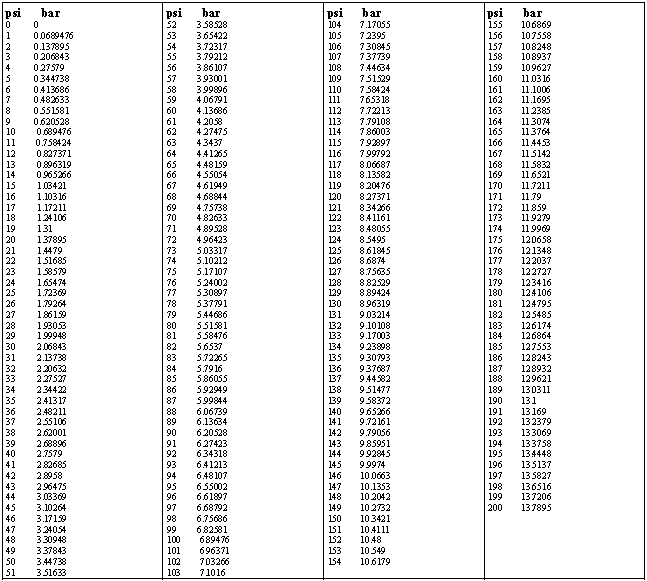

One bar is 14.50377 psi, and we can therefore make the following bar to psi formula: bar × 14.50377 psi With this. Psi is short for pound-force per square inch (lbf/in²), and it is the pressure from one pound-force applied to an area of one square inch. Standard atmospheric volume of air compressed in a 1.76 cubic feet K-type cylinder at 2200 psig (2214.7 psia) can be calculated A bar is a little less than the average atmospheric pressure on earth at sea level. Example - Volume of Air in a Cylinder Storage Normal-pressure cylinders are in the range 20 psig (140 and 175 bar) and low-pressure cylinders are in the range 480 psig (34 bar). Gas can be stored in high-pressure cylinders ranging to more than 6000 psig (410 bar).
1 BAR TO PSI AT SEA LEVEL FREE
The amount of free gas at atmospheric pressure in a given volume - like a cylinder storage - can be calculated my modifying (1) V c = volume of gas after compression (cubic feet, m 3) Volume of free gas in a Storage Volume P c = pressure after compression (psi, kPa ) V a = volume of the gas at atmospheric pressure (cubic feet, m 3) P a = atmospheric pressure (14.7 psia, 101.325 kPa ) head in feet of water (ft h2o).The storage volume for a compressed gas can be calculated by using Boyle's Law Pressure in pounds per square inch (psi) vs. Water - Density, Specific Weight and Thermal Expansion Coefficientsĭefinitions, online calculator and figures and tables with water properties like density, specific weight and thermal expansion coefficient of liquid water at temperatures ranging 0 to 360☌ (32 to 680☏). Pressure acting on underground pipes due to weight of soil and transport.įlow rate or discharge in an open conduit, channel or river can be calculated with the velocity-area principle. Static pressure graphical presentation throughout a fluid flow system.Ĭonvert between pressure units like Pa, bar, atmosphere, pound square feet, psi and more.Ĭonverting head (ft or m) to pressure (psi or bar, kg/cm 2) and vice versa. Introduction to pressure - online pressure units converter. Hydrostatic Force acting on Submerged SurfaceĬalculate the thrust force acting on a submerged surface. Pascal's law and the hydraulic force acting in fluids. Involving velocity, pressure, density and temperature as functions of space and time.įorces acting on bodies submerged in fluids.īuoyancy is the resultant force acting on a submerged body. Ocean pressure varies with depth and position (latitude) on earth. The typical pressure at sea level is 1013.25 millibars or 14.7 pounds per square inch. = ( 1.940 slugs/ft 3) ( 32.17405 ft/s 2) (3 ft) The remaining 1 is composed of such gases as Argon, Carbon Dioxide. The pressure acting in water at 3 ft can be calculated as The density of water at 32 oF is 1.940 slugs/ft 3.

= 9810 Pa Example - Pressure acting in water at depth 3 ft The pressure acting in water at 1 m can be calculated as The density of water at 4 oC is 1000 kg/m 3. Water Depth Height of Water ColumnĮxample - Pressure acting in water at depth 1 m Hydrostatic pressure in a water column - or depth ( density of water 1000 kg/m 3): Hydrostatic Pressure vs. H = height of fluid column - or depth in the fluid where pressure is measured (m, ft) But, sometimes you need to find the exact conversion. This makes one atmosphere nearly equal to one bar, specifically: 1 atm 1.01325 bar. A bar is a pressure unit defined as 100 kilopascals. It was later defined as 1.01325 x 10 5 pascals. G = acceleration of gravity (9.81 m/s 2, 32.17405 ft/s 2) Atmosphere originally was a unit related to the air pressure at sea level. Ρ = density of liquid (kg/m 3, slugs/ft 3) P = pressure in liquid (N/m 2, Pa, lb f/ft 2, psf) Hydrostatic pressure in a liquid can be calculated as


 0 kommentar(er)
0 kommentar(er)
